Sacrifice rituals have been a part of human culture and religion from the earliest recorded history up to the present day. These rituals usually involve giving up something valuable as an offering to gods, spirits, or ancestors as a way to show devotion, ask for help, or atone for sins. The type of sacrifice varies greatly depending on the culture, era, and specific beliefs.
Ancient Cultures:
Mesopotamia:
Sacrifice in ancient Mesopotamia played a crucial role in the religious and political systems of Sumerian, Akkadian, Babylonian, and Assyrian societies. Like many ancient cultures, Mesopotamians believed that sacrifices could please the gods and maintain a balanced order in the universe.
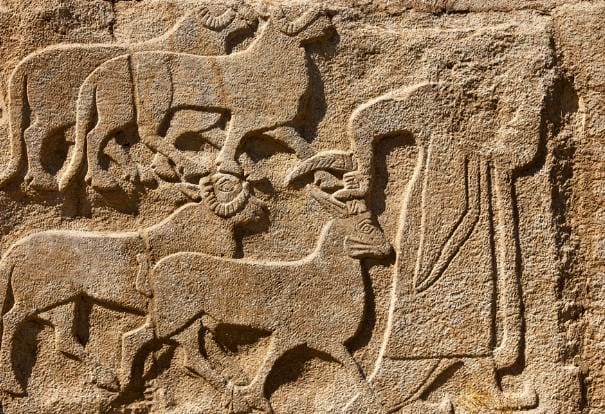
- Animal Sacrifice: The most common form of sacrifice was the offering of animals, particularly sheep and bulls. These animals were slaughtered in temples as a food offering to a god or goddess. The belief was that the gods consumed the spirit of the sacrifice, while the meat was typically eaten by priests or worshippers. The act was seen as a way to establish communion with the divine.
- Food and Drink: Alongside animals, other common sacrifices included food (grains, fruits, etc.) and drink (wine and beer). These were regularly offered in temples and during religious festivals.
- “First Fruits” Sacrifice: There was a tradition in Mesopotamia to sacrifice the “first fruits” of the harvest. This was done in the belief that offering the first and best of the crop would ensure the gods’ favor for the rest of the season.
- Personal Items: Personal possessions, such as jewelry or valuable household items, were often buried with the dead as a form of sacrifice to accompany the deceased in the afterlife.
- Human Sacrifice: While there is some debate among scholars, evidence suggests that human sacrifice was practiced in Mesopotamia, but it was relatively rare and usually associated with royal funerary rituals. For instance, the royal cemetery at Ur contained the remains of soldiers and servants who appear to have been sacrificed to accompany their king or queen in the afterlife.
Ancient Egypt: Egyptians often offered food, wine, and small statues of gods. They believed in a cycle of reciprocity where humans offered sacrifices to the gods, and in turn, the gods bestowed blessings upon them.
- Food and Drink Sacrifices: The most common sacrifices in ancient Egypt were offerings of food, drink, and other goods. Egyptians believed that the gods had needs similar to those of humans, so they would provide food, beer, and wine for the gods to consume. These offerings were usually presented on altars at temples, but could also be made in household shrines.
- Animal Sacrifices: Animals were also sacrificed, although not as commonly as in some other ancient cultures. The animals most frequently sacrificed were bulls, geese, and ducks, which were considered pure. However, these sacrifices were typically restricted to important religious occasions or rituals. The animal would be killed, and then its body was often mummified and presented to the god or goddess.
- Statuettes and Miniature Figurines: Egyptians often offered small statues of gods, servants, and animals as a type of symbolic sacrifice. These statues were thought to act as substitutes for the person making the offering, effectively performing a service for the god on behalf of the devotee.
- Human Sacrifice: While there is some evidence that human sacrifice may have been practiced in the earliest periods of Egyptian history (Early Dynastic Period and Old Kingdom), it seems to have been rare and was not a widespread or enduring part of Egyptian culture.
Mayans and Aztecs:
These Mesoamerican cultures were known for their human sacrifices, thought to appease their gods. The Aztecs, in particular, conducted large-scale human sacrifices during special ceremonies.
The Maya civilization, which flourished in Mesoamerica from around 2000 BC to the 16th century AD, was known for its complex social, political, and religious systems. As part of their religious practices, the Maya conducted various forms of sacrifice, most infamously, human sacrifice.
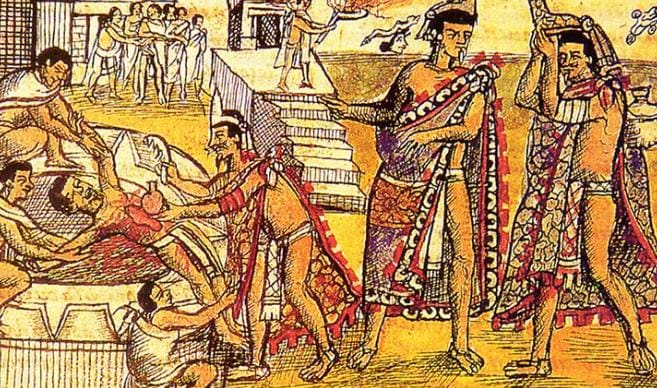
- Human Sacrifice: Human sacrifice played a significant role in Maya religion. It was believed that the act of sacrifice was a way of feeding the gods with the vital life force contained in human blood. The Maya sacrificed both their own people and prisoners of war, with high-status individuals often being preferred. Sacrifices could take various forms, including decapitation, heart extraction, and arrow sacrifice, where the victim was shot with arrows.
- Auto-Sacrifice: The Maya also practiced a form of self-sacrifice, also known as bloodletting. This involved individuals, often rulers or other high-status persons, piercing their own body (commonly the tongue, earlobes, or genitals) to offer their blood to the gods. Blood was collected on paper or cloth, which was then burned, and the smoke was believed to carry the offering to the gods.
- Animal Sacrifice: Animals, particularly birds and dogs, were also offered as sacrifices. Animal sacrifices might have been more common for domestic or small-scale rituals, while human sacrifice was reserved for more significant, state-level events.
- Food and Material Sacrifices: The Maya also offered food, drink, incense, and valuable objects to their gods. These were typically placed in sacred locations, such as temples or caves, or were buried as offerings in tombs or other burial sites.
- Sacrifice of Objects: The Maya would also ‘kill’ objects by breaking them. These objects included pottery, jade, and other valuable items, which were then placed in burial sites, temples, or bodies of water as offerings to the gods.
The Aztec civilization, which flourished in central Mexico from the 14th to the 16th centuries, is well-known for its practice of human sacrifice, which was deeply ingrained in Aztec culture and religious rituals.
- Human Sacrifice: Aztecs believed in a pantheon of gods, many of whom required nourishment in the form of human blood and hearts. Human sacrifice was seen as a way to repay the gods, particularly the sun god Huitzilopochtli, who required human nourishment to fight off the darkness and continue his journey across the sky.The sacrificial victims were often prisoners of war, but they could also be slaves, criminals, or, in some cases, volunteers. The methods of sacrifice varied but typically involved the victim being led to the top of a temple, where a priest would cut out the person’s heart while it was still beating. The bodies were then often thrown down the temple stairs.
- Auto-Sacrifice: Like the Maya, the Aztecs practiced a form of auto-sacrifice or bloodletting, where individuals would offer their own blood to the gods. This was often done by piercing the tongue, earlobes, or other body parts with a thorn or stingray spine.
- Animal and Food Sacrifices: In addition to human sacrifices, Aztecs also offered animals, such as dogs, eagles, jaguars, and deer, as well as food and other goods. These sacrifices might be made in household shrines or temples, depending on the occasion.
- Flower Wars: The “Flower Wars” were a type of ritual warfare conducted by the Aztecs and other Mesoamerican civilizations. These wars were fought not for territory or resources, but for the purpose of capturing prisoners to be used in human sacrifice rituals.
Classical Antiquity:
Greece and Rome: Animal sacrifices, known as Hecatombs, were central to these cultures. They were often accompanied by feasts and festivals. In times of extreme crisis, human sacrifice was sometimes performed, although it was rare and usually condemned.
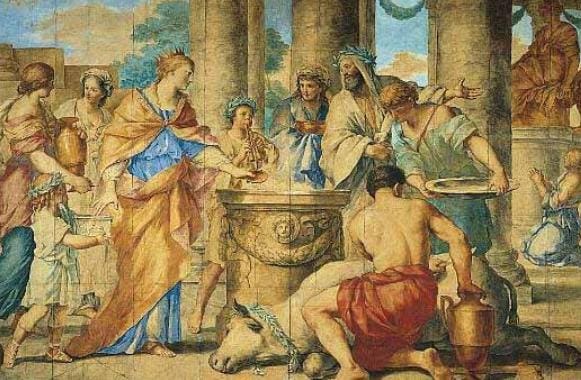
In Ancient Rome, sacrifice played a central role in both the state religion and domestic cult practices. These rituals were designed to maintain a proper relationship between humans and gods.
- Animal Sacrifice: The primary form of sacrifice in Ancient Rome was animal sacrifice, or “immolation”. It involved the ritual killing of an animal, usually a pig, sheep, or bull (known as a suovetaurilia), as an offering to a deity. The animal was carefully chosen for its perceived purity, and it was killed in a sacred space, often a temple. After the animal was killed, its entrails (particularly the liver) would be examined by a priest (known as a haruspex) to interpret the will of the gods. The meat was usually cooked and eaten during a communal meal.
- Libations: The act of pouring a liquid, usually wine or olive oil, onto an altar or the ground as a religious offering was another common type of sacrifice. This was often accompanied by a prayer or invocation of a deity.
- Food and Crop Offerings: Romans also made offerings of food, including crops (especially grains) and cakes, to their gods. During certain religious festivals, such as Saturnalia and Compitalia, Romans would offer simple, homemade dolls or other symbolic items.
- Ritualistic Dedications: Dedications of objects, such as weapons, spoils of war, or statues, were made at sanctuaries or temples, particularly to commemorate military victories.
- Human Sacrifice: While human sacrifice did exist in the early history of Rome, it was extremely rare and viewed with horror and disdain, and was explicitly outlawed in the early Republic. The Vestal Virgins, priestesses of Vesta, were among the few who could be executed for violating their vows of chastity, but even this was not seen as a traditional sacrifice.
- The Imperial Cult: With the advent of the Imperial cult, the Emperor was seen as divine, and sacrifices were made in his honor. After an Emperor’s death, they could be officially deified, and sacrifices were made to them as to other gods.
Abrahamic Religions:
Judaism: In ancient times, animal sacrifices were common at the Temple in Jerusalem. However, after the destruction of the Second Temple, the practice was replaced by prayer and charitable acts.
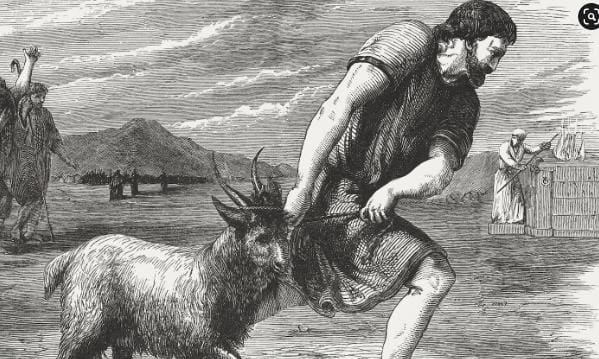
In the early stages of Judaism, sacrifices, known as korbanot, played a critical role. This was especially true during the period of the First and Second Temple in Jerusalem, where the primary form of worship was through sacrificial offerings.
- Animal Sacrifices: Animals, mainly cattle, sheep, and goats, were the most common type of sacrifice. Birds, particularly pigeons or turtledoves, were also used. These sacrifices had various purposes, including atonement for sins, expressing gratitude, and marking important events or festivals.
- Grain and Drink Offerings: Along with animals, the Israelites also offered grain, usually in the form of unleavened bread or cakes, and libations of wine and oil.
- Incense Offering: Incense was often burned on the altar as a pleasing scent for God.
- First Fruits Offering: The “first fruits” of the harvest were also offered at the Temple during the festival of Shavuot, as prescribed in the Torah.
Christianity: While Christianity doesn’t practice physical sacrifice, it is symbolically represented in the Eucharist, which commemorates the sacrifice of Jesus Christ.
In Christianity, the idea of sacrifice is foundational but takes a different form than in many other religions. The most significant sacrifice in Christian belief is that of Jesus Christ, who is seen as the Son of God and whose death on the cross is viewed as a self-sacrifice for the salvation of humanity. This event, often referred to as the Passion, is at the core of Christian soteriology.

- Jesus’ Sacrifice: According to Christian doctrine, Jesus’ death by crucifixion was a sacrifice for the sins of humanity. This is often understood in the context of the concept of “atonement,” which refers to the reconciliation between God and humans brought about through this sacrificial act. Jesus’ resurrection is also seen as a key part of this sacrificial act, demonstrating his victory over sin and death.
- Eucharist (Communion): The Eucharist, also known as Holy Communion, is a Christian rite that is considered a sacrament in most churches. It involves consuming bread and wine (or grape juice) that symbolize the body and blood of Jesus Christ. This practice is seen as a way of participating in Jesus’ sacrifice and is based on the Last Supper, a meal Jesus shared with his disciples before his crucifixion.
- Living Sacrifice: In addition to these central concepts, the New Testament also introduces the idea of Christians offering themselves as a “living sacrifice” (Romans 12:1). This means living a life of love, selflessness, and holiness as a way of worshiping God. It can include acts of charity, devotion, and commitment to Christian ethics.
- Martyrdom: Early in Christian history, the act of martyrdom, or being killed because of one’s faith, was also seen as a form of sacrifice. These individuals were often venerated as saints.
Islam: During Eid al-Adha, or the “Festival of Sacrifice,” Muslims around the world slaughter a livestock animal (usually a sheep, goat, cow, or camel) to commemorate the Prophet Ibrahim’s willingness to sacrifice his son for Allah. Part of the meat is consumed by the family and part is given to the poor.
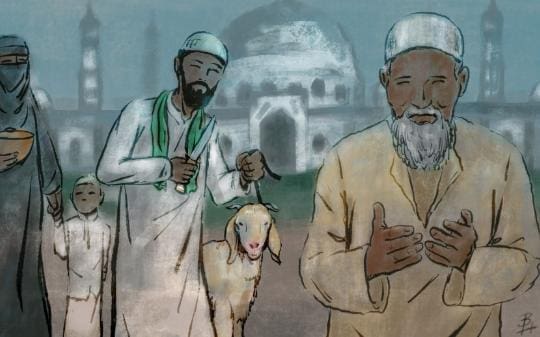
In Islam, sacrifice, or Qurbani, plays an important role, particularly during certain religious observances. Like Christianity and Judaism, the concept of sacrifice in Islam does not involve human sacrifice, and it carries significant symbolic meaning.
- Eid al-Adha: Also known as the “Festival of Sacrifice,” this is one of the two major Islamic holidays. It commemorates the willingness of the prophet Ibrahim (Abraham in Christian and Jewish traditions) to sacrifice his son Ismail (Ishmael) as an act of obedience to God. According to the story, God intervened at the last moment and provided a ram to be sacrificed instead. To commemorate this event, Muslims who are financially capable are required to sacrifice a permissible animal (usually a sheep, goat, cow, or camel). The meat is then divided into three parts: one for the family, one for friends and neighbors, and one for the poor and needy.
- Udhiyah: This refers to the animal that is sacrificed for Eid al-Adha. The animal must meet certain criteria (it must be in good health, above a certain age, etc.) to be considered suitable for sacrifice.
- Sadaqah and Zakat: While not sacrifices in the traditional sense, these forms of charitable giving can be seen as a kind of personal sacrifice, as they involve giving up personal wealth for the sake of the poor and needy. Zakat is one of the Five Pillars of Islam and involves giving a set portion of one’s wealth to charity. Sadaqah is voluntary charity that can be given at any time and in any amount.
- Fasting: During the month of Ramadan, Muslims fast from dawn to sunset. This act of self-denial is seen as a kind of sacrifice made for the sake of God.
- Martyrdom: Similar to Christianity, in Islam there’s a concept of dying in the cause of faith being seen as a form of sacrifice. Such individuals are considered martyrs (Shahid). It’s important to note that the concept of martyrdom is frequently misinterpreted or misused, and it does not justify acts of violence. The majority of Islamic scholars and adherents strongly condemn violence and terrorism.
Hinduism: In the Vedic period, animal sacrifices were common, but they became less prevalent over time. Today, many Hindus perform the ritual of “puja,” where they offer food, flowers, and other items to their deities. Some sects of Hinduism still practice animal sacrifice.
- Yajna: This is one of the most common forms of sacrifice in Hinduism, often referred to as a Vedic fire ritual. During a yajna, offerings such as ghee (clarified butter), grains, and other items are made into a consecrated fire while Sanskrit mantras are chanted. These rituals are performed for various purposes, including to maintain cosmic order, seek divine blessings, or mark significant life events.
- Animal Sacrifice: In some regions and traditions within Hinduism, animal sacrifice is practiced, particularly during certain festivals or at specific temples. The sacrificed animal (often a goat or rooster) is usually then consumed by the community. However, many Hindus object to this practice, and it’s generally less common than other forms of sacrifice, particularly in modern times.
- Prasad: This refers to food that is offered to a deity during worship and then shared among devotees. The act of preparing and offering the food is seen as a form of sacrifice, while consuming the prasad is believed to confer blessings from the deity.
- Fasting: As in other religions, fasting is seen as a form of self-sacrifice in Hinduism. Devotees might fast during certain religious festivals, on specific days of the week associated with particular deities, or during holy periods such as the month of Shravan
Modern Sacrifices: In contemporary times, many sacrifices are symbolic or involve the giving of time, money, or resources. For example, in Christianity, the concept of “tithing,” or giving a portion of one’s income to the church, is seen as a form of sacrifice. In many indigenous cultures, offerings of food, tobacco, or other items may still be made to spirits or ancestors. In some cultures and religions, fasting is considered a form of self-sacrifice.
